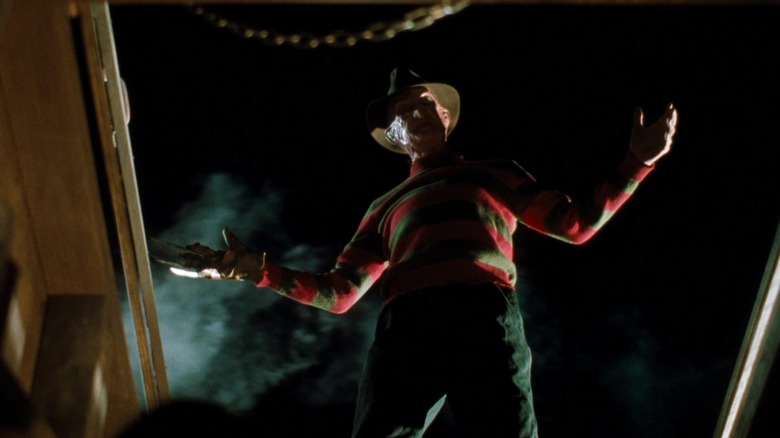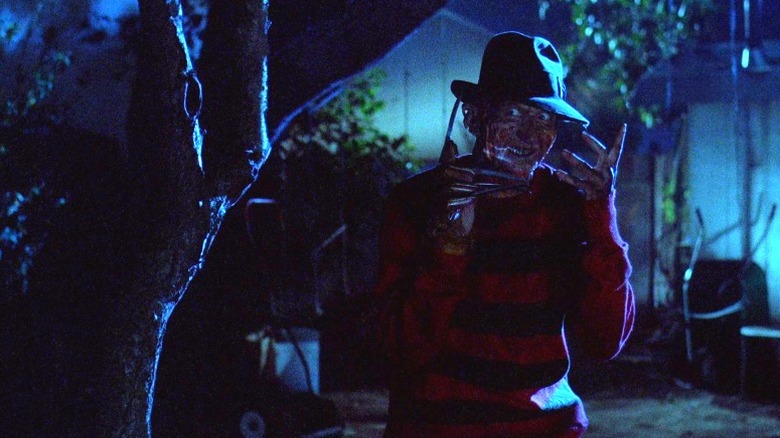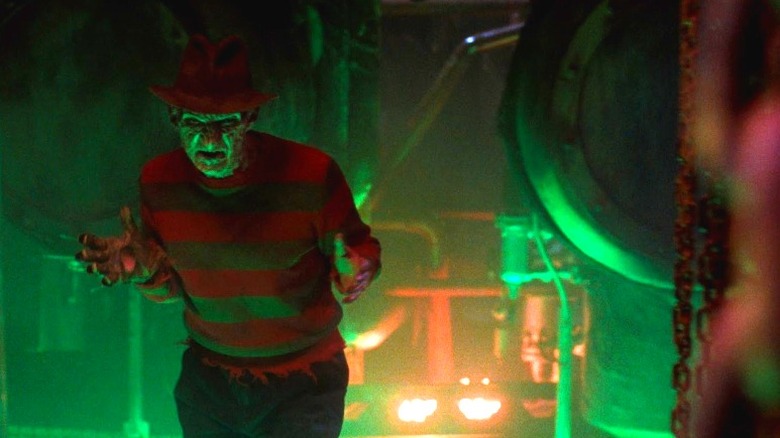What Robert Englund Thinks Fans Gets Wrong About Freddy Krueger
Pop culture has lived with Freddy Krueger for so long, it's easy to take him for granted.
As explained in the many films in the "A Nightmare on Elm Street" series, Freddy was born to a nun following a group assault in an asylum. He was raised by an abusive adopted father, and regularly tortured and killed animals. He grew up to murder children, and would often lure his victims into a steamy boiler room to torture them with handmade gloves outfitted with knives or nails. For years, he killed the kids in and around the fictional city of Springwood, Ohio.
Freddy was eventually arrested but was "released on a technicality." Outraged, the parents of Springwood chased Freddy to his torture shack and set it on fire, burning him to death. Freddy, however, was too evil to stay dead, and years later began appearing in the dreams of Springwood's teens. Freddy was now scarred from the fire, still wore one of his bladed torture gloves, and took a great deal of delight in tormenting the dreamers. When he killed a teenager in their dream, they would die in real life.
Wes Craven's 1984 original film is clever, terrifying, and possessed a unique premise that was stretched into multiple sequels. The sequels, however, became increasingly more cartoony and whimsical (especially under director Renny Harlin), infusing their bloody violence with a cackling sense of humor; Freddy gradually became less of a dark-souled serial killer and more of a quipping supervillain.
Robert Englund played Freddy in eight of the nine "Nightmare" movies (Jackie Earle Haley played him in the 2010 remake), and Englund felt that the films' many fans never quite got a handle on what Freddy represented. In Wayne Byrne's 2022 biography "Welcome to Elm Street: Inside the Film and Television Nightmares," Englund said that Freddy sought to murder the future.
Freddy Krueger, punk rocker
Englund noted that "A Nightmare on Elm Street" is very much a movie about class. Indeed, theme of class are embedded in the very title. A nightmare has invaded Elm Street, a placid-sounding suburban locale unused to nightmares. Englund points out that Tina (Amanda Wyss) and her boyfriend Rod (Nick Corri) are meant to be seen as lower-class characters, coming from "the wrong side of the tracks." Rod, notably, is depicted as a 1950s greaser, an archetype of the poor, neglected punk seen in the flicks of Craven's youth. Meanwhile, the film's protagonist Nancy (Heather Langenkamp) and her boyfriend Glen (Johnny Depp) are seen as living a comfortable middle-class life.
It's telling that the house where "A Nightmare on Elm Street" was shot — located at 1428 N. Genesee Ave. in Hollywood, California — is currently estimated to be worth over $3.2 million. That's how comfy Nancy was in terms of her mom's wealth.
So ultimately, Rod and Tina — and also Freddy — were seen as encroaching elements of chaos in Reagan's suburban America. Englund saw Freddy as a symbol for punk rock deconstruction, a threat to bourgeois complacency. Englund said:
"Freddy ... didn't fit into Springwood, he didn't fit into the idealized American society, because he represents everything that polite society abhors. The symbolism of Freddy is that of 'Child Killer.' Those words, 'Child Killer,' they are almost poetic, I mean you could imagine a hardcore punk band being named 'Child Killer,' you know: 'Tonight, at Madame Wong's West: The Clash supported by The Child Killers!'"
There is no band called The Child Killers, as far as I was able to find, but there is a song called "The Child Killers" on the Delgados' 2003 album "Hate."
I believe the children are our future
Of course, Freddy isn't just interrupting upper-class creature comforts. Indeed, Englund felt he was doing something far more insidious. He viewed Freddy as a nihilist. As a supernatural murderer, Freddy saw no future other than death; he only believed in oblivion, entropy, and the dark, murderous pleasures he feels amid the spiraling chaos. He wanted to ensure no future came to pass. In Englund's words:
"When you apply those words ['child killer'] to Freddy, what is he doing? He is killing children. And what are children? They are the future. Freddy is killing the future. He is that unexplained and undiscussed evil. Some people really want to get specific into his backstory and label him as a pedophile, but he is just a child killer, he is killing innocence, he is killing the future."
Freddy, then, is about much more than his mere appetites. He may be filled with hate and bloodlust, but more than anything, he wants to watch the world burn. He may be motivated by revenge or a serial killer's bleak impulses, but what he really wants is the future to end.
Tom McLaughlin, the director of the spin-off TV series "Freddy's Nightmare," notes in "Welcome to Elm Street" that Freddy typically appears in familiar, safe places. He shows up in bedrooms, in your home, in the places where you rest. He is an invader. This falls in line with Englund's ideas of Freddy as a symbol of class consciousness.
It's also worth noting that the kids in the "Nightmare" movies — and indeed in most of Craven's films — are being punished for the sins of their parents. They are truly innocent, but Freddy will do everything he can to destroy them.


